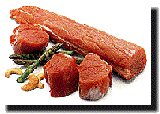
Livestock raising has always been an important part of agriculture on Prince Edward Island. In the early days, it was an integral part of the family farm. Today, breeding and production have evolved to become large commercial operations that sell their product to markets around the world.
In the middle of the 1900s, the pork industry on Prince Edward Island went through a very controversial experiment in the breeding of Yorkshire swine. For more than 25 years in the 1940s and 1950s, virtually no outside blood was introduced to the Island Yorkshire population and there resulted a uniquely Island strain of swine. Prince Edward Island’s production of Grade A carcasses increased steadily, and Island hogs in market classes dominated the Royal Winter Fair. It was proof that the Island strain of Yorkshire hogs was the best in Canada.
Although this particular experiment ended in the 1960s, it provided a solid foundation for hog production on the Island. It succeeded in generating for Prince Edward Island hog producers an international reputation for high-quality breeding stock and excellent pork meat. Today, the most popular breeds, for the purposes of production and exhibition, are Yorkshire, Landrace, Hampshire, Duroc, and Lancombe. The quality of pork meat depends largely on genetics and animal health. Therefore, high-value production is assured both through excellent quality stock and our ability to grow high-nutrient feed. Some hog producers specialize in raising young “weaner” pigs until they weigh 30–35 pounds. At this time, they are sold to another type of farmer who raises the swine to market weight (100 kilograms or 220 pounds). The majority of swine producers run “farrow-to-finish” operations, raising piglets from birth to slaughter. In 1997, there were 103 hog farms on the Island engaging in one of three types of swine operations.
The Prince Edward Island Purebred Swine Breeders
Association represents the province’s small purebred
swine industry. Further increasing Island swine
productivity, Prince Edward Island Swine Quality Inc.
raises genetically high-quality and virtually
disease-free animals. These animals are made available to
commercial producers for breeding stock and hog
production. Since 1989, the province has been party to
the National Tripartite Stabilization Program (bringing
together federal and provincial governments and swine
producers) and has instituted an Interim Hog Price  Stabilization
Program. Both programs are designed to stabilize market
returns for producers and limit losses caused by market
risks. Prince Edward Island’s Hog Commodity
Marketing Board was established in 1971 to provide
support for the local industry by controlling supply of
production and regulating prices while promoting the
product and the industry. The Board also strives to
increase efficiency in feeding, management and marketing
practices.
Stabilization
Program. Both programs are designed to stabilize market
returns for producers and limit losses caused by market
risks. Prince Edward Island’s Hog Commodity
Marketing Board was established in 1971 to provide
support for the local industry by controlling supply of
production and regulating prices while promoting the
product and the industry. The Board also strives to
increase efficiency in feeding, management and marketing
practices.
Swine producers in Prince Edward Island and throughout Canada face many challenges. Hog production entails very high costs—an average of $100 to $110 per animal—due in large part to the temperature requirements of young pigs, which require well-insulated facilities that will run high electricity bills. The industry is also at the mercy of consumption trends; low prices force many farmers to leave swine production in favour of other agricultural commodities.
Potatoes | Fruits and Vegetables |
Field Crops | Beef and Dairy
Poultry and Eggs | Emerging Commodities |
Beekeeping
